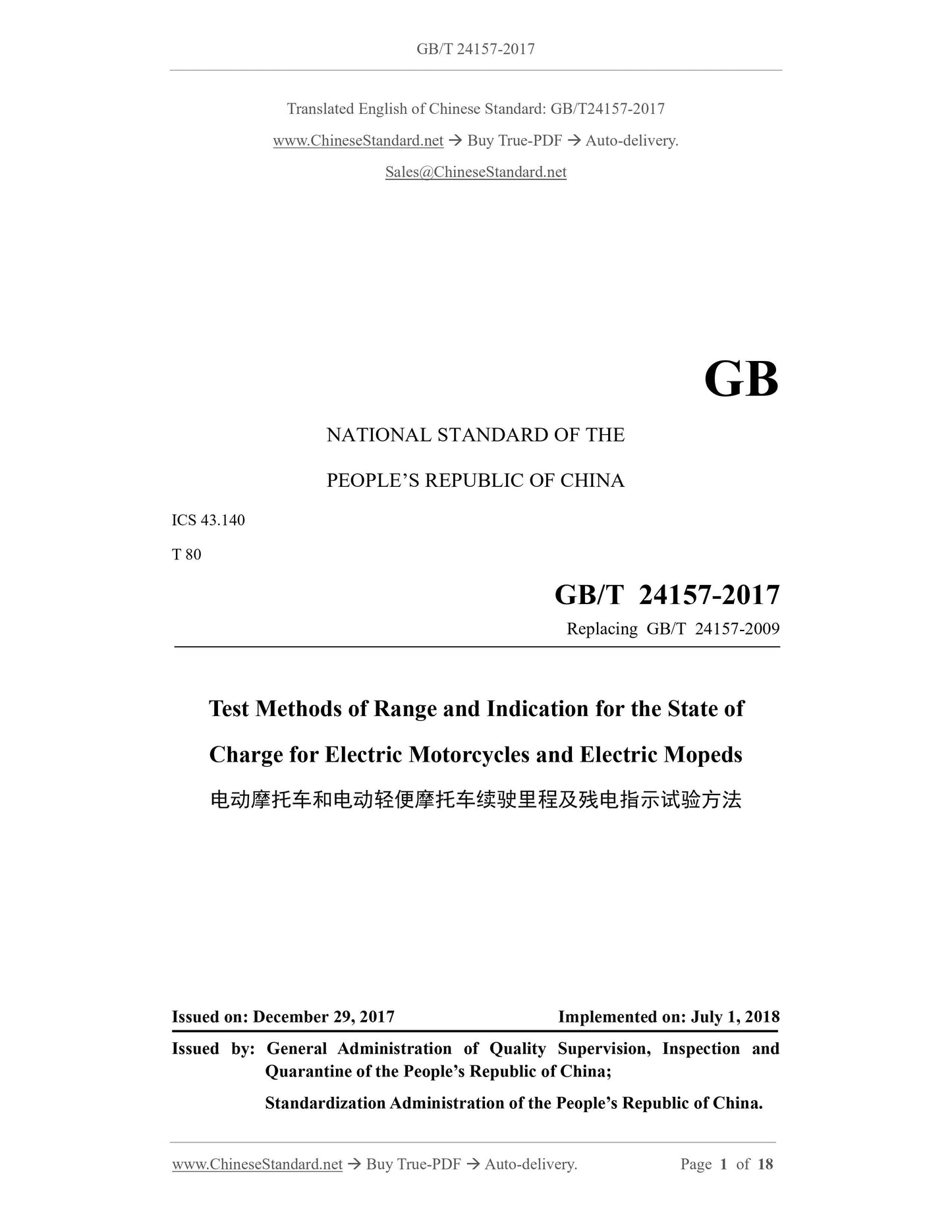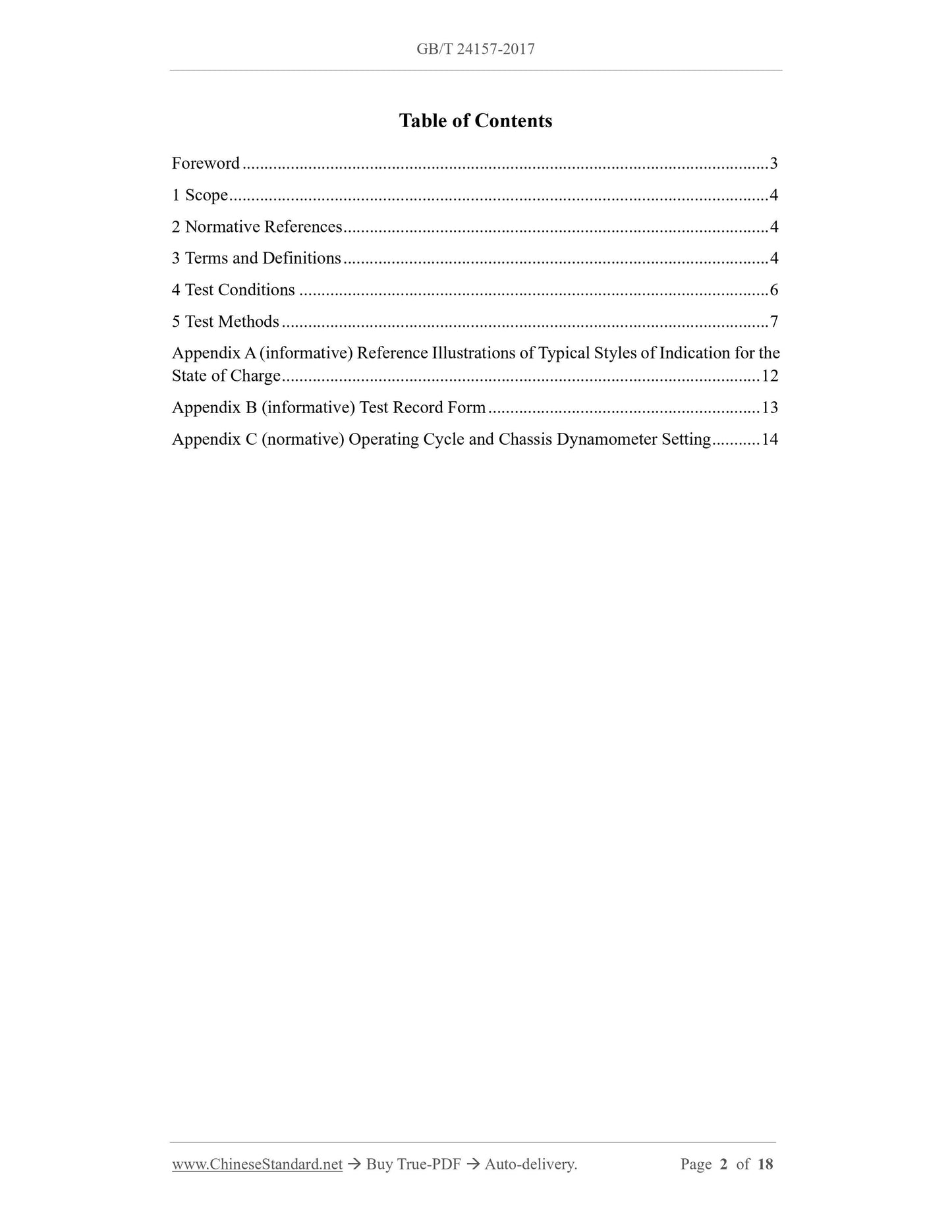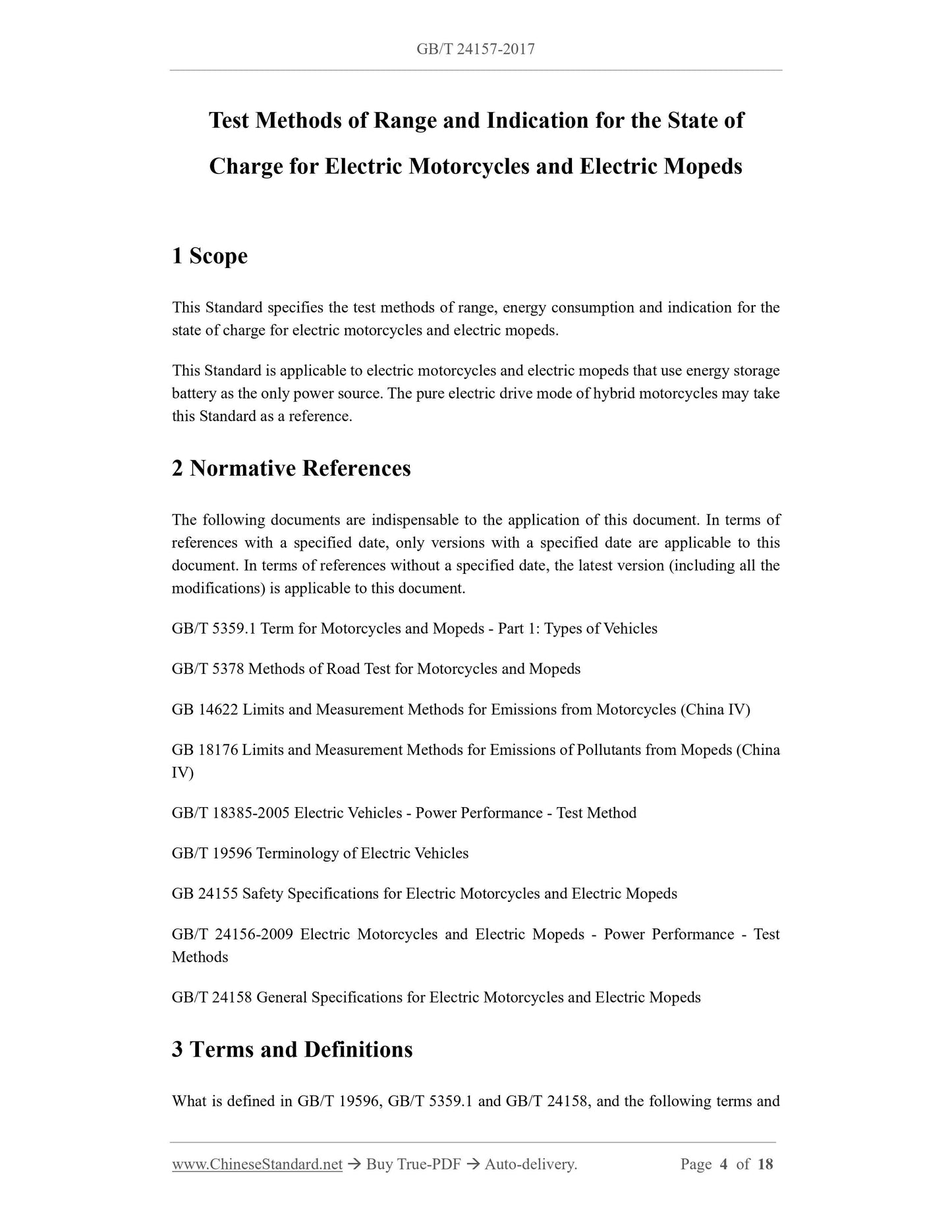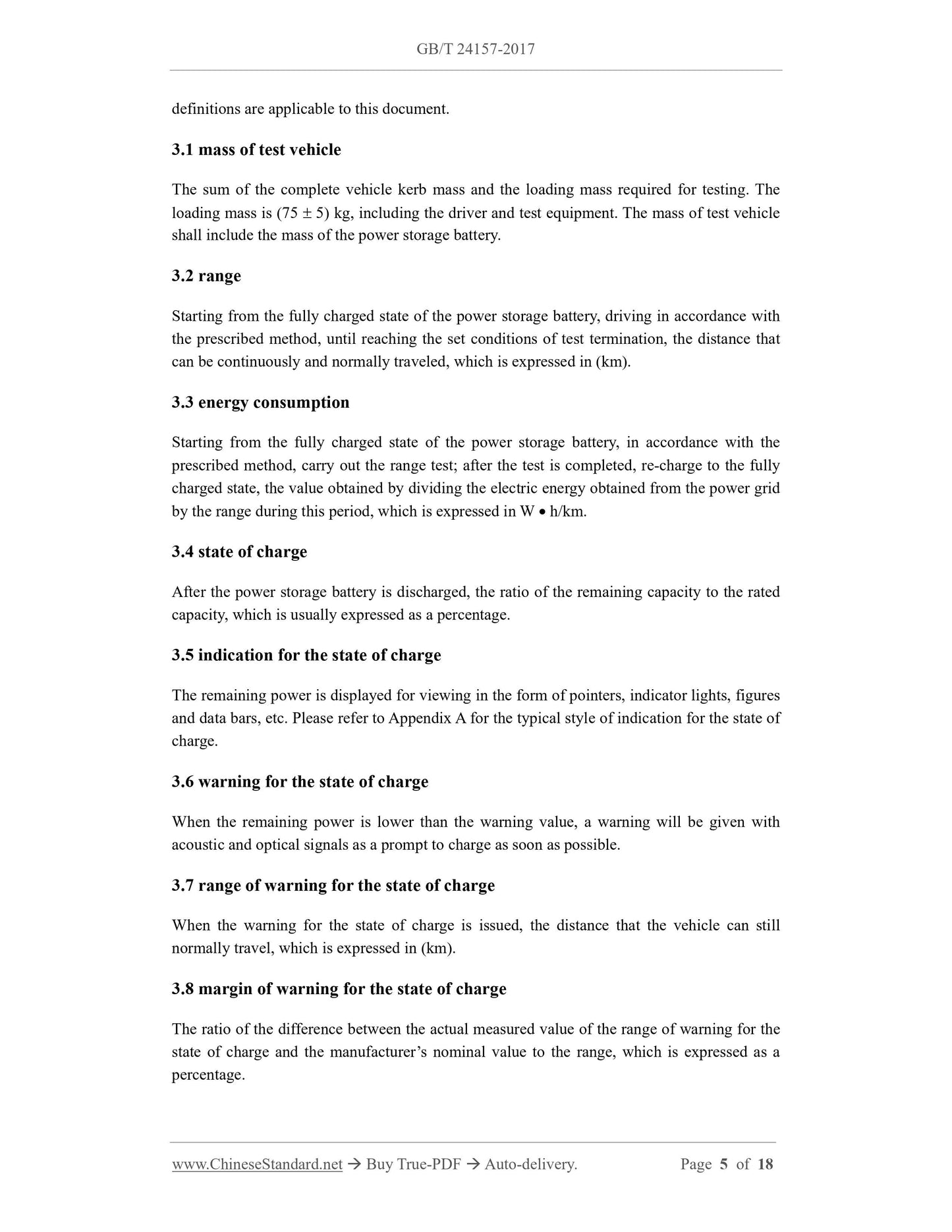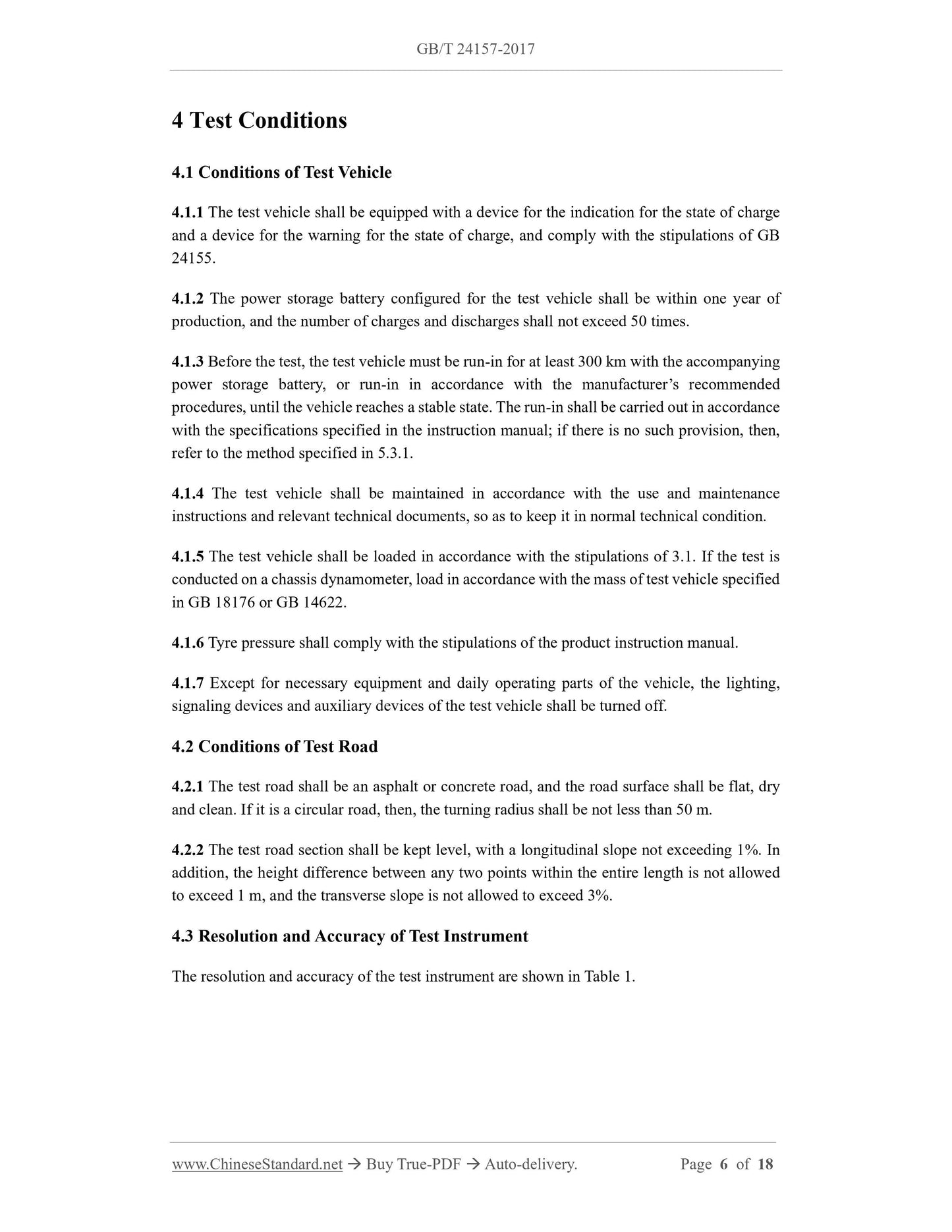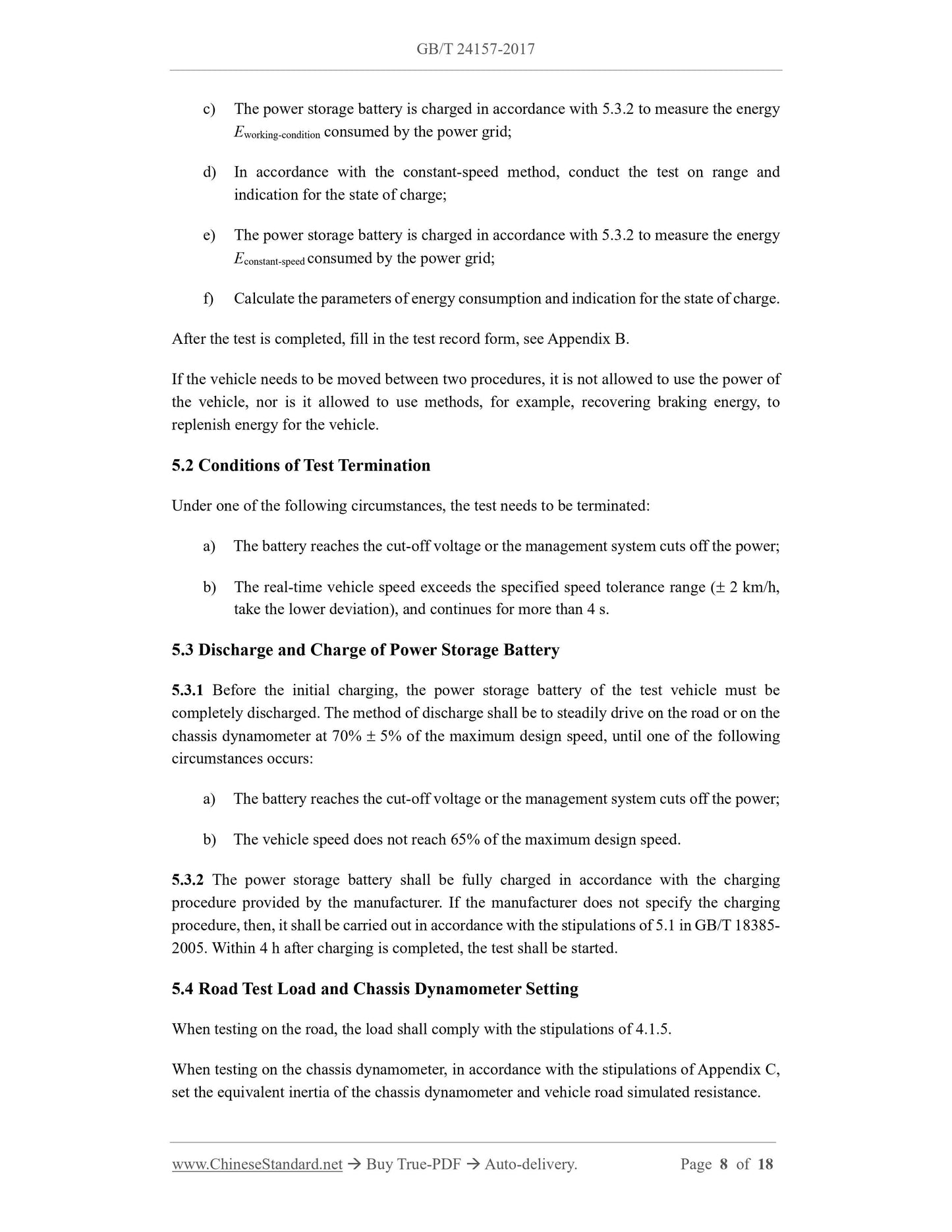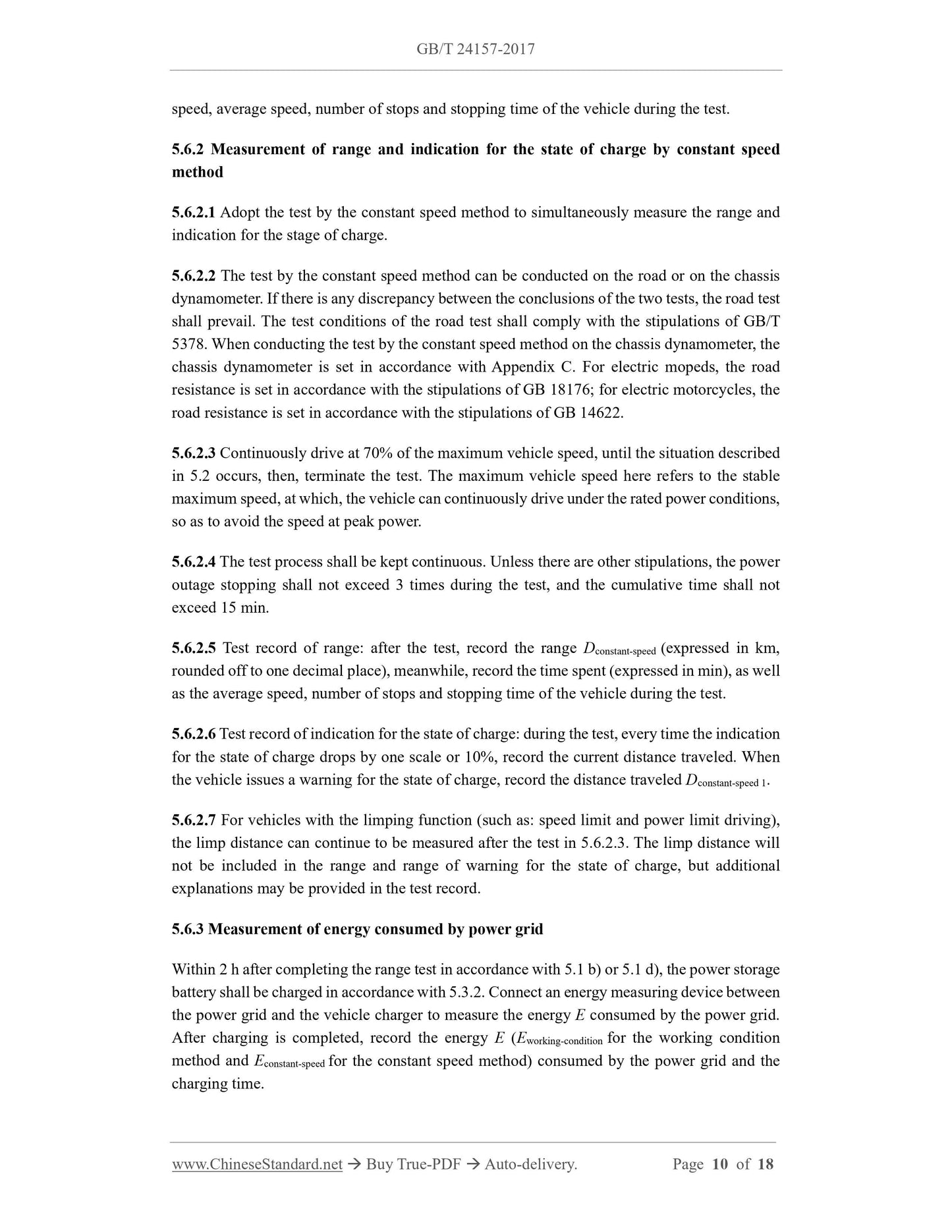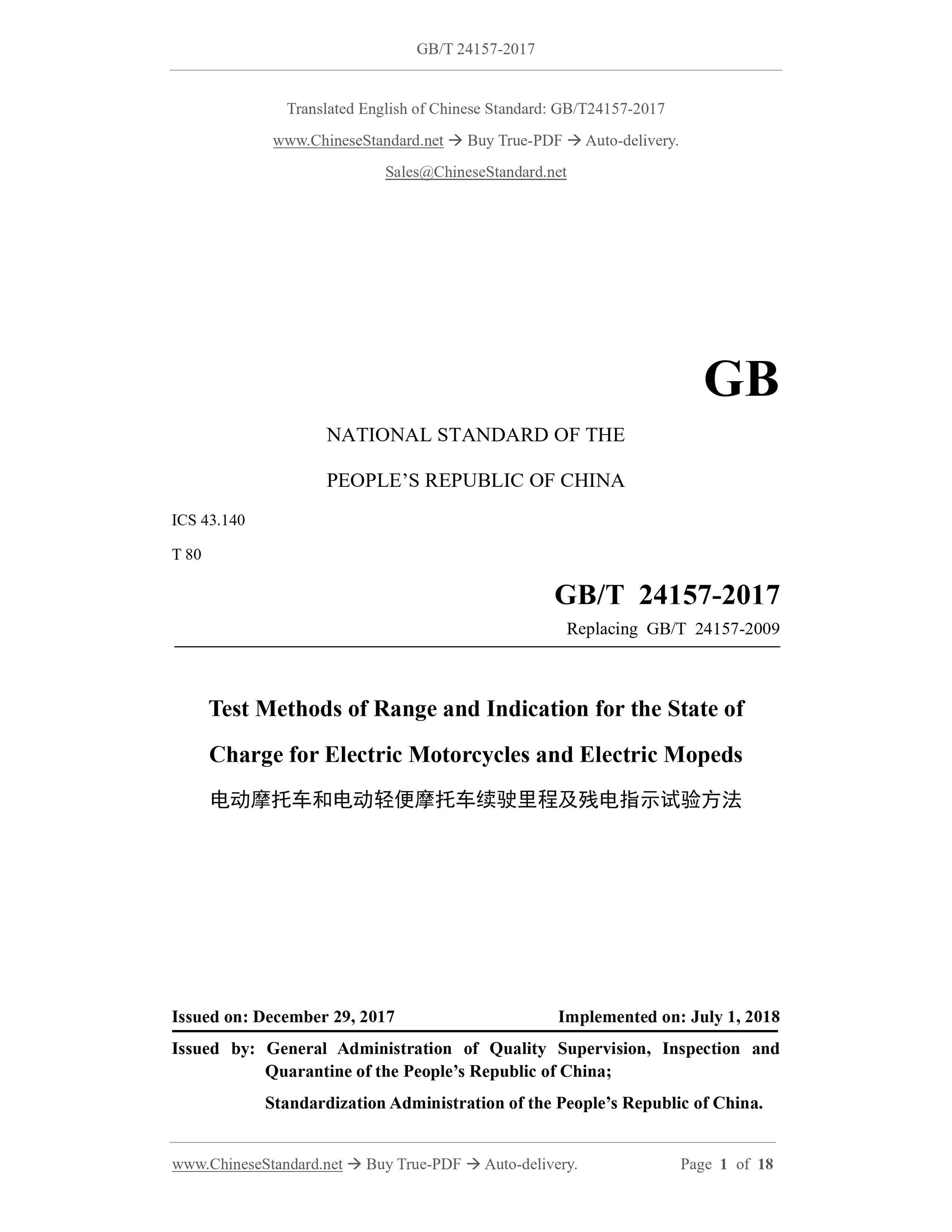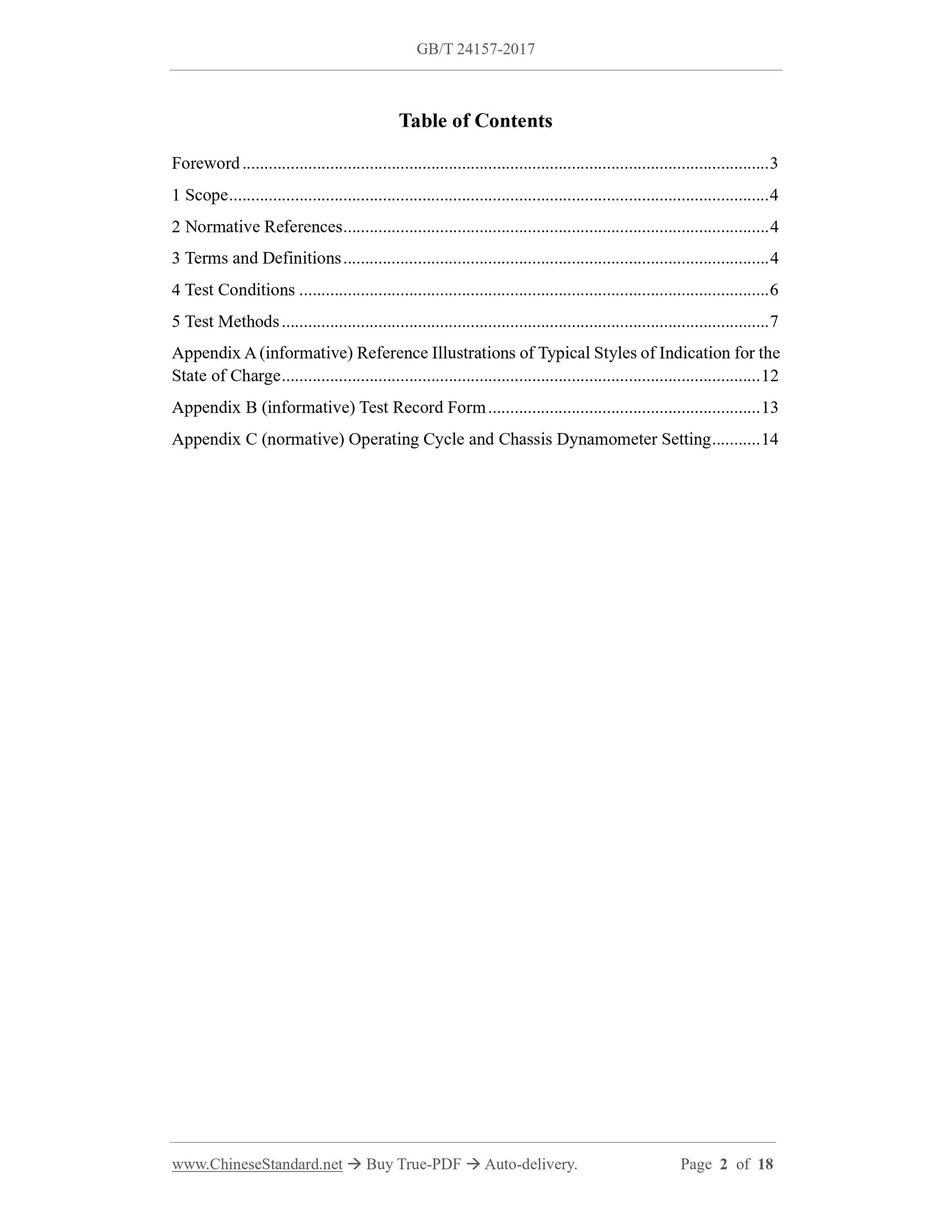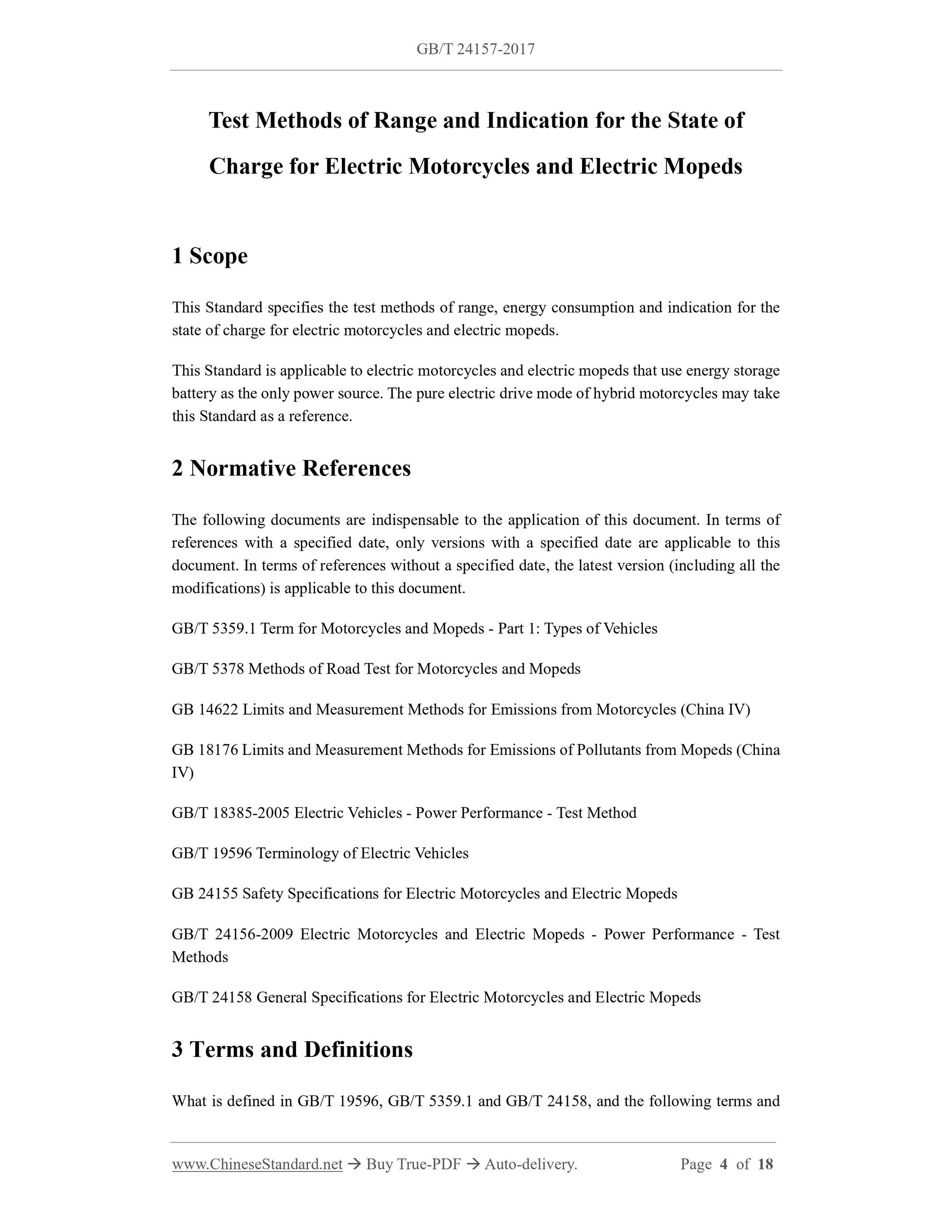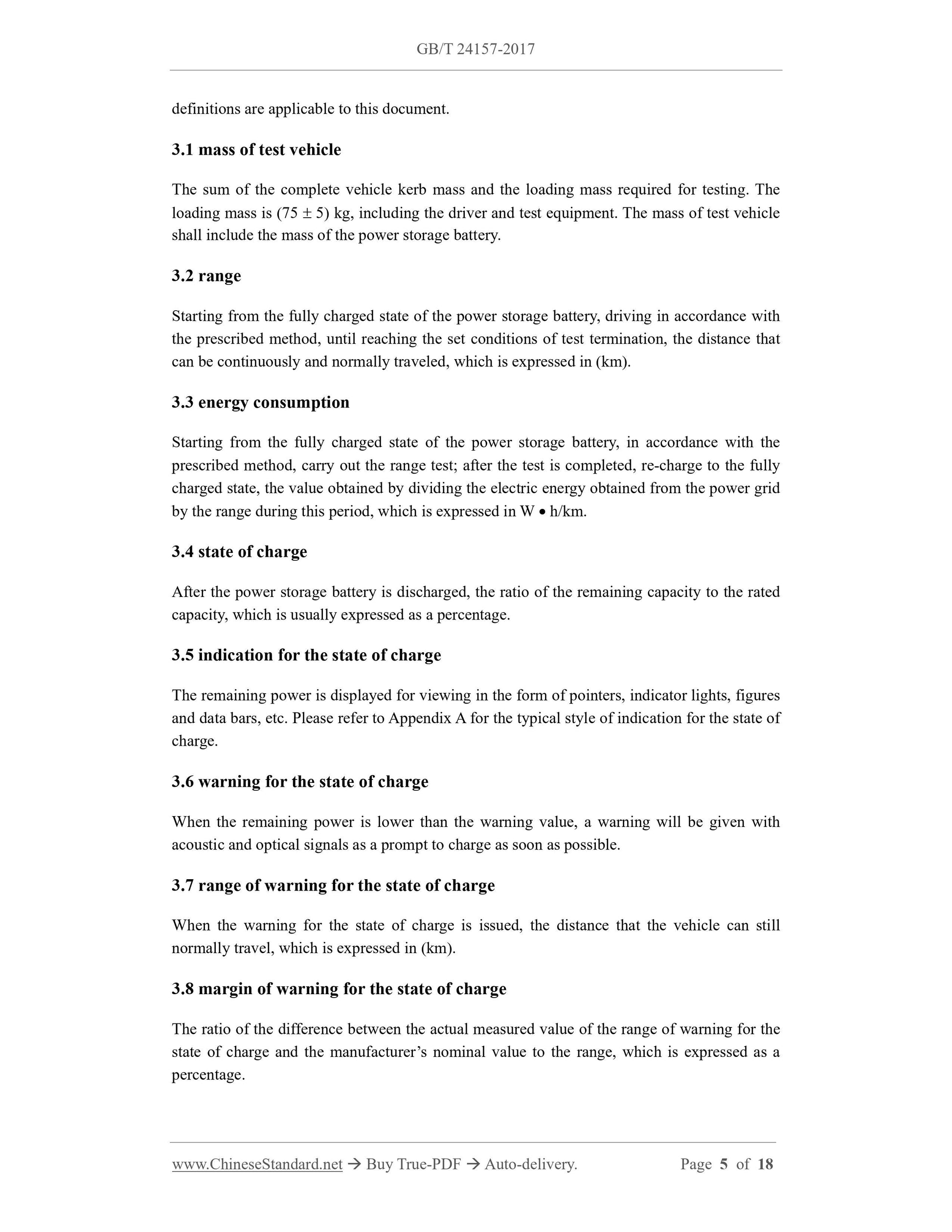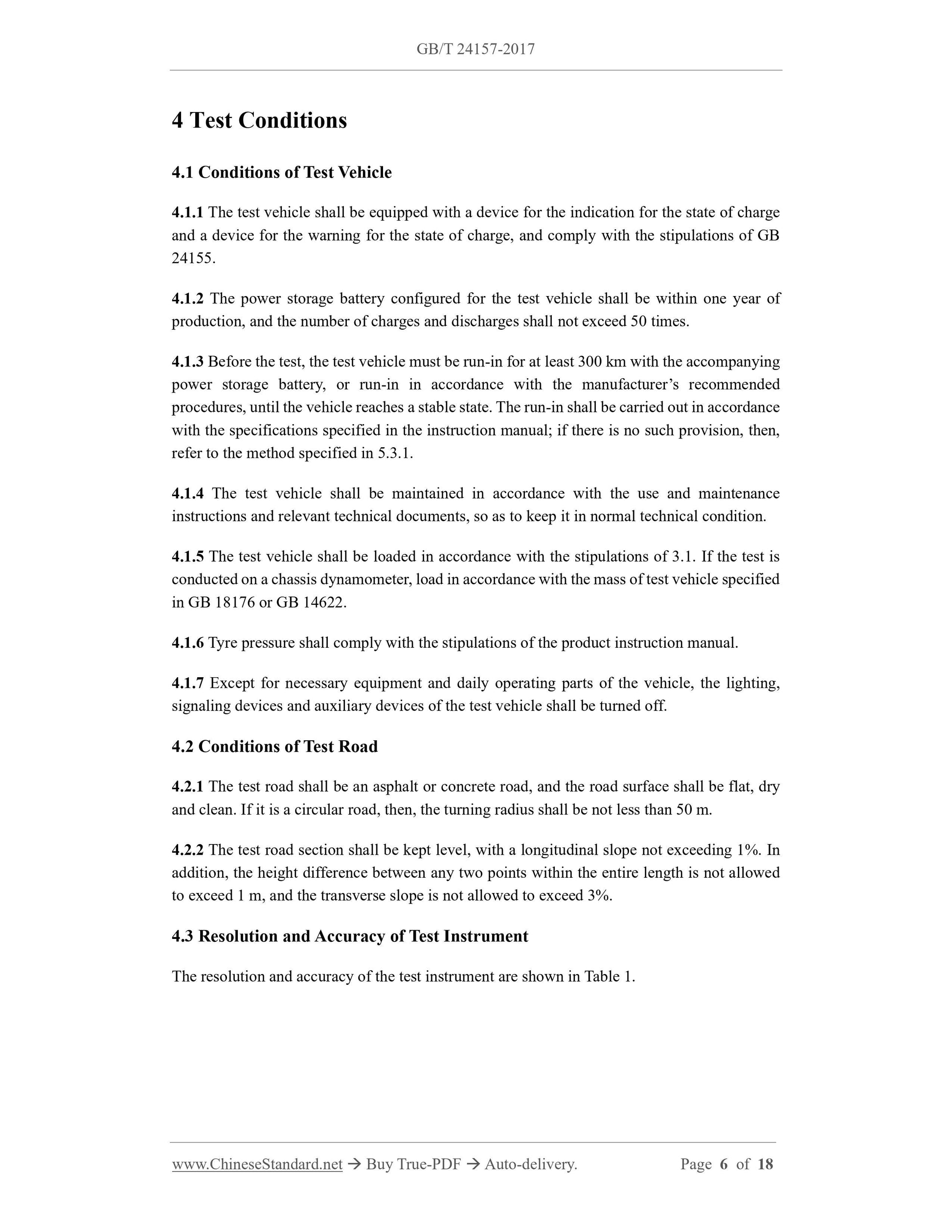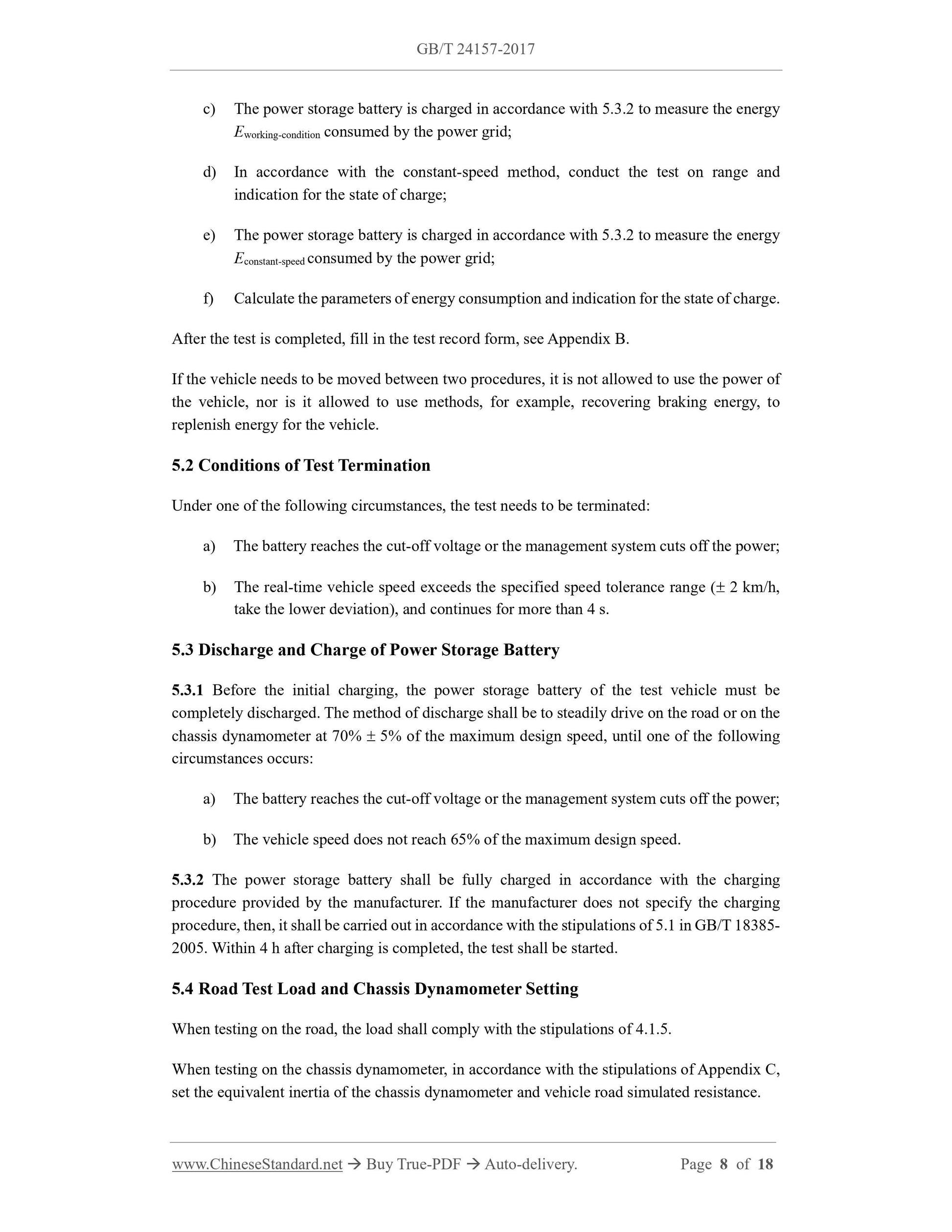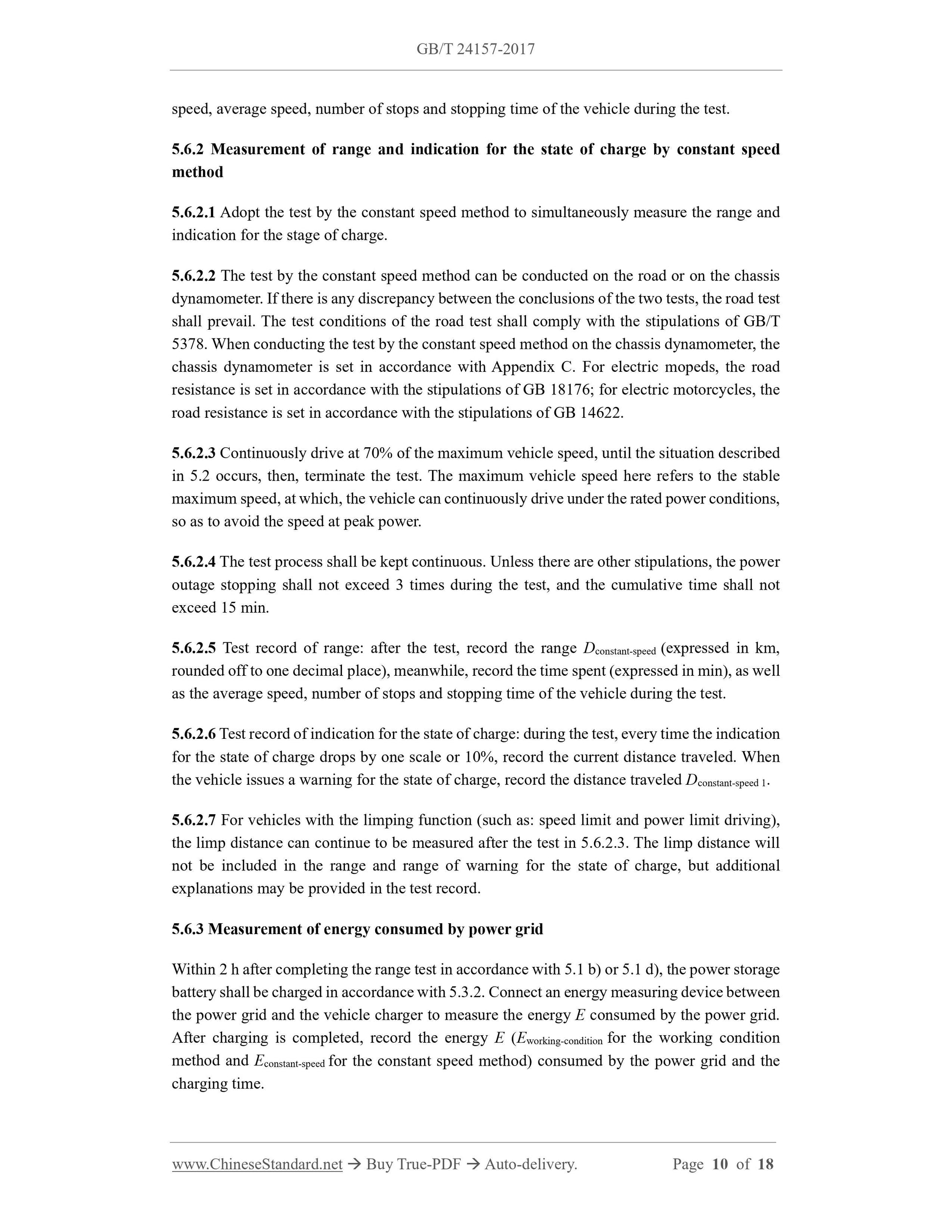1
/
of
7
www.ChineseStandard.us -- Field Test Asia Pte. Ltd.
GB/T 24157-2017 English PDF (GB/T24157-2017)
GB/T 24157-2017 English PDF (GB/T24157-2017)
Regular price
$270.00
Regular price
Sale price
$270.00
Unit price
/
per
Shipping calculated at checkout.
Couldn't load pickup availability
GB/T 24157-2017: Test methods of range and indication for the state of charge for electric motorcycles and electric mopeds
Delivery: 9 seconds. Download (& Email) true-PDF + Invoice.
Get Quotation: Click GB/T 24157-2017 (Self-service in 1-minute)
Historical versions (Master-website): GB/T 24157-2017
Preview True-PDF (Reload/Scroll-down if blank)
GB/T 24157-2017
GB
NATIONAL STANDARD OF THE
PEOPLE’S REPUBLIC OF CHINA
ICS 43.140
T 80
Replacing GB/T 24157-2009
Test Methods of Range and Indication for the State of
Charge for Electric Motorcycles and Electric Mopeds
ISSUED ON: DECEMBER 29, 2017
IMPLEMENTED ON: JULY 1, 2018
Issued by: General Administration of Quality Supervision, Inspection and
Quarantine of the People’s Republic of China;
Standardization Administration of the People’s Republic of China.
Table of Contents
Foreword ... 3
1 Scope ... 4
2 Normative References ... 4
3 Terms and Definitions ... 4
4 Test Conditions ... 6
5 Test Methods ... 7
Appendix A (informative) Reference Illustrations of Typical Styles of Indication for the
State of Charge ... 12
Appendix B (informative) Test Record Form ... 13
Appendix C (normative) Operating Cycle and Chassis Dynamometer Setting ... 14
Test Methods of Range and Indication for the State of
Charge for Electric Motorcycles and Electric Mopeds
1 Scope
This Standard specifies the test methods of range, energy consumption and indication for the
state of charge for electric motorcycles and electric mopeds.
This Standard is applicable to electric motorcycles and electric mopeds that use energy storage
battery as the only power source. The pure electric drive mode of hybrid motorcycles may take
this Standard as a reference.
2 Normative References
The following documents are indispensable to the application of this document. In terms of
references with a specified date, only versions with a specified date are applicable to this
document. In terms of references without a specified date, the latest version (including all the
modifications) is applicable to this document.
GB/T 5359.1 Term for Motorcycles and Mopeds - Part 1: Types of Vehicles
GB/T 5378 Methods of Road Test for Motorcycles and Mopeds
GB 14622 Limits and Measurement Methods for Emissions from Motorcycles (China IV)
GB 18176 Limits and Measurement Methods for Emissions of Pollutants from Mopeds (China
IV)
GB/T 18385-2005 Electric Vehicles - Power Performance - Test Method
GB/T 19596 Terminology of Electric Vehicles
GB 24155 Safety Specifications for Electric Motorcycles and Electric Mopeds
GB/T 24156-2009 Electric Motorcycles and Electric Mopeds - Power Performance - Test
Methods
GB/T 24158 General Specifications for Electric Motorcycles and Electric Mopeds
3 Terms and Definitions
What is defined in GB/T 19596, GB/T 5359.1 and GB/T 24158, and the following terms and
definitions are applicable to this document.
3.1 mass of test vehicle
The sum of the complete vehicle kerb mass and the loading mass required for testing. The
loading mass is (75 5) kg, including the driver and test equipment. The mass of test vehicle
shall include the mass of the power storage battery.
3.2 range
Starting from the fully charged state of the power storage battery, driving in accordance with
the prescribed method, until reaching the set conditions of test termination, the distance that
can be continuously and normally traveled, which is expressed in (km).
3.3 energy consumption
Starting from the fully charged state of the power storage battery, in accordance with the
prescribed method, carry out the range test; after the test is completed, re-charge to the fully
charged state, the value obtained by dividing the electric energy obtained from the power grid
by the range during this period, which is expressed in W h/km.
3.4 state of charge
After the power storage battery is discharged, the ratio of the remaining capacity to the rated
capacity, which is usually expressed as a percentage.
3.5 indication for the state of charge
The remaining power is displayed for viewing in the form of pointers, indicator lights, figures
and data bars, etc. Please refer to Appendix A for the typical style of indication for the state of
charge.
3.6 warning for the state of charge
When the remaining power is lower than the warning value, a warning will be given with
acoustic and optical signals as a prompt to charge as soon as possible.
3.7 range of warning for the state of charge
When the warning for the state of charge is issued, the distance that the vehicle can still
normally travel, which is expressed in (km).
3.8 margin of warning for the state of charge
The ratio of the difference between the actual measured value of the range of warning for the
state of charge and the manufacturer’s nominal value to the range, which is expressed as a
percentage.
4 Test Conditions
4.1 Conditions of Test Vehicle
4.1.1 The test vehicle shall be equipped with a device for the indication for the state of charge
and a device for the warning for the state of charge, and comply with the stipulations of GB
24155.
4.1.2 The power storage battery configured for the test vehicle shall be within one year of
production, and the number of charges and discharges shall not exceed 50 times.
4.1.3 Before the test, the test vehicle must be run-in for at least 300 km with the accompanying
power storage battery, or run-in in accordance with the manufacturer’s recommended
procedures, until the vehicle reaches a stable state. The run-in shall be carried out in accordance
with the specifications specified in the instruction manual; if there is no such provision, then,
refer to the method specified in 5.3.1.
4.1.4 The test vehicle shall be maintained in accordance with the use and maintenance
instructions and relevant technical documents, so as to keep it in normal technical condition.
4.1.5 The test vehicle shall be loaded in accordance with the stipulations of 3.1. If the test is
conducted on a chassis dynamometer, load in accordance with the mass of test vehicle specified
in GB 18176 or GB 14622.
4.1.6 Tyre pressure shall comply with the stipulations of the product instruction manual.
4.1.7 Except for necessary equipment and daily operating parts of the vehicle, the lighting,
signaling devices and auxiliary devices of the test vehicle shall be turned off.
4.2 Conditions of Test Road
4.2.1 The test road shall be an asphalt or concrete road, and the road surface shall be flat, dry
and clean. If it is a circular road, then, the turning radius shall be not less than 50 m.
4.2.2 The test road section shall be kept level, with a longitudinal slope not exceeding 1%. In
addition, the height difference between any two points within the entire length is not allowed
to exceed 1 m, and the transverse slope is not allowed to exceed 3%.
4.3 Resolution and Accuracy of Test Instrument
The resolution and accuracy of the test instrument are shown in Table 1.
c) The power storage battery is charged in accordance with 5.3.2 to measure the energy
Eworking-condition consumed by the power grid;
d) In accordance with the constant-speed method, conduct the test on range and
indication for the state of charge;
e) The power storage battery is charged in accordance with 5.3.2 to measure the energy
Econstant-speed consumed by the power grid;
f) Calculate the parameters of energy consumption and indication for the state of charge.
After the test is completed, fill in the test record form, see Appendix B.
If the vehicle needs to be moved between two procedures, it is not allowed to use the power of
the vehicle, nor is it allowed to use methods, for example, recovering braking energy, to
replenish energy for the vehicle.
5.2 Conditions of Test Termination
Under one of the following circumstances, the test needs to be terminated:
a) The battery reaches the cut-off voltage or the management system cuts off the power;
b) The real-time vehicle speed exceeds the specified speed tolerance range ( 2 km/h,
take the lower deviation), and continues for more than 4 s.
5.3 Discharge and Charge of Power Storage Battery
5.3.1 Before the initial charging, the power storage battery of the test vehicle must be
completely discharged. The method of discharge shall be to steadily drive on the road or on the
chassis dynamometer at 70% 5% of the maximum design speed, until one of the following
circumstances occurs:
a) The battery reaches the cut-off voltage or the management system cuts off the power;
b) The vehicle speed does not reach 65% of the maximum design speed.
5.3.2 The power storage battery shall be fully charged in accordance with the charging
procedure provided by the manufacturer. If the manufacturer does not specify the charging
procedure, then, it shall be carried out in accordance with the stipulations of 5.1 in GB/T 18385-
2005. Within 4 h after charging is completed, the test shall be started.
5.4 Road Test Load and Chassis Dynamometer Setting
When testing on the road, the load shall comply with the stipulations of 4.1.5.
When testing on the chassis dynamometer, in accordance with the stipulations of Appendix C,
set the equivalent inertia of the chassis dynamometer and vehicle road simulated resistance.
speed, average speed, number of stops and stopping time of the vehicle during the test.
5.6.2 Measurement of range and indication for the state of charge by constant speed
method
5.6.2.1 Adopt the test by the constant speed method to simultaneously measure the range and
indication for the stage of charge.
5.6.2.2 The test by the constant speed method can be conducted on the road or on the chassis
dynamometer. If there is any discrepancy between the conclusions of the two tests, the road test
shall prevail. The test conditions of the road test shall comply with the stipulations of GB/T
5378. When conducting the test by the constant speed method on the chassis dynamometer, the
chassis dynamometer is set in accordance with Appendix C. For electric mopeds, the road
resistance is set in accordance with the stipulations of GB 18176; for electric motorcycles, the
road resistance is set in accordance with the stipulations of GB 14622.
5.6.2.3 Continuously drive at 70% of the maximum vehicle speed, until the situation described
in 5.2 occurs, then, terminate the test. The maximum vehicle speed here refers to the stable
maximum speed, at which, the vehicle can continuously drive under the rated power conditions,
so as to avoid the speed at peak power.
5.6.2.4 The test process shall be kept continuous. Unless there are other stipulations, the power
outage stopping shall not exceed 3 times during the test, and the cumulative time shall not
exceed 15 min.
5.6.2.5 Test record of range: after the test, record the range Dconstant-speed (expressed in km,
rounded off to one decimal place), meanwhile, record the time spent (expressed in min), as well
as the average speed, number of stops and stopping time of the vehicle during the test.
5.6.2.6 Test record of indication for the state of charge: during the test, every time the indication
for the state of charge drops by one scale or 10%, record the current distance traveled. When
the vehicle issues a warning for the state of charge, record the distance traveled Dconstant-speed 1.
5.6.2.7 For vehicles with the limping function (such as: speed limit and power limit driving),
the limp distance can continue to be measured after the test in 5.6.2.3. The limp distance will
not be included in the range and range of warning for the state of charge, but additional
explanations may be provided in the test record.
5.6.3 Measurement of energy consumed by power grid
Within 2 h after completing the range test in accordance with 5.1 b) or 5.1 d), the power storage
battery shall be charged in accordance with 5.3.2. Connect an energy measuring device between
the power grid and the vehicle charger to measure the energy E consumed by the power grid.
After charging is completed, record the energy E (Eworking-condition for the working condition
method and Econstant-speed for the constant speed method) consumed by the power grid and the
charging time.
GB/T 24157-2017
GB
NATIONAL STANDARD OF THE
PEOPLE’S REPUBLIC OF CHINA
ICS 43.140
T 80
Replacing GB/T 24157-2009
Test Methods of Range and Indication for the State of
Charge for Electric Motorcycles and Electric Mopeds
ISSUED ON: DECEMBER 29, 2017
IMPLEMENTED ON: JULY 1, 2018
Issued by: General Administration of Quality Supervision, Inspection and
Quarantine of the People’s Republic of China;
Standardization Administration of the People’s Republic of China.
Table of Contents
Foreword ... 3
1 Scope ... 4
2 Normative References ... 4
3 Terms and Definitions ... 4
4 Test Conditions ... 6
5 Test Methods ... 7
Appendix A (informative) Reference Illustrations of Typical Styles of Indication for the
State of Charge ... 12
Appendix B (informative) Test Record Form ... 13
Appendix C (normative) Operating Cycle and Chassis Dynamometer Setting ... 14
Test Methods of Range and Indication for the State of
Charge for Electric Motorcycles and Electric Mopeds
1 Scope
This Standard specifies the test methods of range, energy consumption and indication for the
state of charge for electric motorcycles and electric mopeds.
This Standard is applicable to electric motorcycles and electric mopeds that use energy storage
battery as the only power source. The pure electric drive mode of hybrid motorcycles may take
this Standard as a reference.
2 Normative References
The following documents are indispensable to the application of this document. In terms of
references with a specified date, only versions with a specified date are applicable to this
document. In terms of references without a specified date, the latest version (including all the
modifications) is applicable to this document.
GB/T 5359.1 Term for Motorcycles and Mopeds - Part 1: Types of Vehicles
GB/T 5378 Methods of Road Test for Motorcycles and Mopeds
GB 14622 Limits and Measurement Methods for Emissions from Motorcycles (China IV)
GB 18176 Limits and Measurement Methods for Emissions of Pollutants from Mopeds (China
IV)
GB/T 18385-2005 Electric Vehicles - Power Performance - Test Method
GB/T 19596 Terminology of Electric Vehicles
GB 24155 Safety Specifications for Electric Motorc...
Delivery: 9 seconds. Download (& Email) true-PDF + Invoice.
Get Quotation: Click GB/T 24157-2017 (Self-service in 1-minute)
Historical versions (Master-website): GB/T 24157-2017
Preview True-PDF (Reload/Scroll-down if blank)
GB/T 24157-2017
GB
NATIONAL STANDARD OF THE
PEOPLE’S REPUBLIC OF CHINA
ICS 43.140
T 80
Replacing GB/T 24157-2009
Test Methods of Range and Indication for the State of
Charge for Electric Motorcycles and Electric Mopeds
ISSUED ON: DECEMBER 29, 2017
IMPLEMENTED ON: JULY 1, 2018
Issued by: General Administration of Quality Supervision, Inspection and
Quarantine of the People’s Republic of China;
Standardization Administration of the People’s Republic of China.
Table of Contents
Foreword ... 3
1 Scope ... 4
2 Normative References ... 4
3 Terms and Definitions ... 4
4 Test Conditions ... 6
5 Test Methods ... 7
Appendix A (informative) Reference Illustrations of Typical Styles of Indication for the
State of Charge ... 12
Appendix B (informative) Test Record Form ... 13
Appendix C (normative) Operating Cycle and Chassis Dynamometer Setting ... 14
Test Methods of Range and Indication for the State of
Charge for Electric Motorcycles and Electric Mopeds
1 Scope
This Standard specifies the test methods of range, energy consumption and indication for the
state of charge for electric motorcycles and electric mopeds.
This Standard is applicable to electric motorcycles and electric mopeds that use energy storage
battery as the only power source. The pure electric drive mode of hybrid motorcycles may take
this Standard as a reference.
2 Normative References
The following documents are indispensable to the application of this document. In terms of
references with a specified date, only versions with a specified date are applicable to this
document. In terms of references without a specified date, the latest version (including all the
modifications) is applicable to this document.
GB/T 5359.1 Term for Motorcycles and Mopeds - Part 1: Types of Vehicles
GB/T 5378 Methods of Road Test for Motorcycles and Mopeds
GB 14622 Limits and Measurement Methods for Emissions from Motorcycles (China IV)
GB 18176 Limits and Measurement Methods for Emissions of Pollutants from Mopeds (China
IV)
GB/T 18385-2005 Electric Vehicles - Power Performance - Test Method
GB/T 19596 Terminology of Electric Vehicles
GB 24155 Safety Specifications for Electric Motorcycles and Electric Mopeds
GB/T 24156-2009 Electric Motorcycles and Electric Mopeds - Power Performance - Test
Methods
GB/T 24158 General Specifications for Electric Motorcycles and Electric Mopeds
3 Terms and Definitions
What is defined in GB/T 19596, GB/T 5359.1 and GB/T 24158, and the following terms and
definitions are applicable to this document.
3.1 mass of test vehicle
The sum of the complete vehicle kerb mass and the loading mass required for testing. The
loading mass is (75 5) kg, including the driver and test equipment. The mass of test vehicle
shall include the mass of the power storage battery.
3.2 range
Starting from the fully charged state of the power storage battery, driving in accordance with
the prescribed method, until reaching the set conditions of test termination, the distance that
can be continuously and normally traveled, which is expressed in (km).
3.3 energy consumption
Starting from the fully charged state of the power storage battery, in accordance with the
prescribed method, carry out the range test; after the test is completed, re-charge to the fully
charged state, the value obtained by dividing the electric energy obtained from the power grid
by the range during this period, which is expressed in W h/km.
3.4 state of charge
After the power storage battery is discharged, the ratio of the remaining capacity to the rated
capacity, which is usually expressed as a percentage.
3.5 indication for the state of charge
The remaining power is displayed for viewing in the form of pointers, indicator lights, figures
and data bars, etc. Please refer to Appendix A for the typical style of indication for the state of
charge.
3.6 warning for the state of charge
When the remaining power is lower than the warning value, a warning will be given with
acoustic and optical signals as a prompt to charge as soon as possible.
3.7 range of warning for the state of charge
When the warning for the state of charge is issued, the distance that the vehicle can still
normally travel, which is expressed in (km).
3.8 margin of warning for the state of charge
The ratio of the difference between the actual measured value of the range of warning for the
state of charge and the manufacturer’s nominal value to the range, which is expressed as a
percentage.
4 Test Conditions
4.1 Conditions of Test Vehicle
4.1.1 The test vehicle shall be equipped with a device for the indication for the state of charge
and a device for the warning for the state of charge, and comply with the stipulations of GB
24155.
4.1.2 The power storage battery configured for the test vehicle shall be within one year of
production, and the number of charges and discharges shall not exceed 50 times.
4.1.3 Before the test, the test vehicle must be run-in for at least 300 km with the accompanying
power storage battery, or run-in in accordance with the manufacturer’s recommended
procedures, until the vehicle reaches a stable state. The run-in shall be carried out in accordance
with the specifications specified in the instruction manual; if there is no such provision, then,
refer to the method specified in 5.3.1.
4.1.4 The test vehicle shall be maintained in accordance with the use and maintenance
instructions and relevant technical documents, so as to keep it in normal technical condition.
4.1.5 The test vehicle shall be loaded in accordance with the stipulations of 3.1. If the test is
conducted on a chassis dynamometer, load in accordance with the mass of test vehicle specified
in GB 18176 or GB 14622.
4.1.6 Tyre pressure shall comply with the stipulations of the product instruction manual.
4.1.7 Except for necessary equipment and daily operating parts of the vehicle, the lighting,
signaling devices and auxiliary devices of the test vehicle shall be turned off.
4.2 Conditions of Test Road
4.2.1 The test road shall be an asphalt or concrete road, and the road surface shall be flat, dry
and clean. If it is a circular road, then, the turning radius shall be not less than 50 m.
4.2.2 The test road section shall be kept level, with a longitudinal slope not exceeding 1%. In
addition, the height difference between any two points within the entire length is not allowed
to exceed 1 m, and the transverse slope is not allowed to exceed 3%.
4.3 Resolution and Accuracy of Test Instrument
The resolution and accuracy of the test instrument are shown in Table 1.
c) The power storage battery is charged in accordance with 5.3.2 to measure the energy
Eworking-condition consumed by the power grid;
d) In accordance with the constant-speed method, conduct the test on range and
indication for the state of charge;
e) The power storage battery is charged in accordance with 5.3.2 to measure the energy
Econstant-speed consumed by the power grid;
f) Calculate the parameters of energy consumption and indication for the state of charge.
After the test is completed, fill in the test record form, see Appendix B.
If the vehicle needs to be moved between two procedures, it is not allowed to use the power of
the vehicle, nor is it allowed to use methods, for example, recovering braking energy, to
replenish energy for the vehicle.
5.2 Conditions of Test Termination
Under one of the following circumstances, the test needs to be terminated:
a) The battery reaches the cut-off voltage or the management system cuts off the power;
b) The real-time vehicle speed exceeds the specified speed tolerance range ( 2 km/h,
take the lower deviation), and continues for more than 4 s.
5.3 Discharge and Charge of Power Storage Battery
5.3.1 Before the initial charging, the power storage battery of the test vehicle must be
completely discharged. The method of discharge shall be to steadily drive on the road or on the
chassis dynamometer at 70% 5% of the maximum design speed, until one of the following
circumstances occurs:
a) The battery reaches the cut-off voltage or the management system cuts off the power;
b) The vehicle speed does not reach 65% of the maximum design speed.
5.3.2 The power storage battery shall be fully charged in accordance with the charging
procedure provided by the manufacturer. If the manufacturer does not specify the charging
procedure, then, it shall be carried out in accordance with the stipulations of 5.1 in GB/T 18385-
2005. Within 4 h after charging is completed, the test shall be started.
5.4 Road Test Load and Chassis Dynamometer Setting
When testing on the road, the load shall comply with the stipulations of 4.1.5.
When testing on the chassis dynamometer, in accordance with the stipulations of Appendix C,
set the equivalent inertia of the chassis dynamometer and vehicle road simulated resistance.
speed, average speed, number of stops and stopping time of the vehicle during the test.
5.6.2 Measurement of range and indication for the state of charge by constant speed
method
5.6.2.1 Adopt the test by the constant speed method to simultaneously measure the range and
indication for the stage of charge.
5.6.2.2 The test by the constant speed method can be conducted on the road or on the chassis
dynamometer. If there is any discrepancy between the conclusions of the two tests, the road test
shall prevail. The test conditions of the road test shall comply with the stipulations of GB/T
5378. When conducting the test by the constant speed method on the chassis dynamometer, the
chassis dynamometer is set in accordance with Appendix C. For electric mopeds, the road
resistance is set in accordance with the stipulations of GB 18176; for electric motorcycles, the
road resistance is set in accordance with the stipulations of GB 14622.
5.6.2.3 Continuously drive at 70% of the maximum vehicle speed, until the situation described
in 5.2 occurs, then, terminate the test. The maximum vehicle speed here refers to the stable
maximum speed, at which, the vehicle can continuously drive under the rated power conditions,
so as to avoid the speed at peak power.
5.6.2.4 The test process shall be kept continuous. Unless there are other stipulations, the power
outage stopping shall not exceed 3 times during the test, and the cumulative time shall not
exceed 15 min.
5.6.2.5 Test record of range: after the test, record the range Dconstant-speed (expressed in km,
rounded off to one decimal place), meanwhile, record the time spent (expressed in min), as well
as the average speed, number of stops and stopping time of the vehicle during the test.
5.6.2.6 Test record of indication for the state of charge: during the test, every time the indication
for the state of charge drops by one scale or 10%, record the current distance traveled. When
the vehicle issues a warning for the state of charge, record the distance traveled Dconstant-speed 1.
5.6.2.7 For vehicles with the limping function (such as: speed limit and power limit driving),
the limp distance can continue to be measured after the test in 5.6.2.3. The limp distance will
not be included in the range and range of warning for the state of charge, but additional
explanations may be provided in the test record.
5.6.3 Measurement of energy consumed by power grid
Within 2 h after completing the range test in accordance with 5.1 b) or 5.1 d), the power storage
battery shall be charged in accordance with 5.3.2. Connect an energy measuring device between
the power grid and the vehicle charger to measure the energy E consumed by the power grid.
After charging is completed, record the energy E (Eworking-condition for the working condition
method and Econstant-speed for the constant speed method) consumed by the power grid and the
charging time.
GB/T 24157-2017
GB
NATIONAL STANDARD OF THE
PEOPLE’S REPUBLIC OF CHINA
ICS 43.140
T 80
Replacing GB/T 24157-2009
Test Methods of Range and Indication for the State of
Charge for Electric Motorcycles and Electric Mopeds
ISSUED ON: DECEMBER 29, 2017
IMPLEMENTED ON: JULY 1, 2018
Issued by: General Administration of Quality Supervision, Inspection and
Quarantine of the People’s Republic of China;
Standardization Administration of the People’s Republic of China.
Table of Contents
Foreword ... 3
1 Scope ... 4
2 Normative References ... 4
3 Terms and Definitions ... 4
4 Test Conditions ... 6
5 Test Methods ... 7
Appendix A (informative) Reference Illustrations of Typical Styles of Indication for the
State of Charge ... 12
Appendix B (informative) Test Record Form ... 13
Appendix C (normative) Operating Cycle and Chassis Dynamometer Setting ... 14
Test Methods of Range and Indication for the State of
Charge for Electric Motorcycles and Electric Mopeds
1 Scope
This Standard specifies the test methods of range, energy consumption and indication for the
state of charge for electric motorcycles and electric mopeds.
This Standard is applicable to electric motorcycles and electric mopeds that use energy storage
battery as the only power source. The pure electric drive mode of hybrid motorcycles may take
this Standard as a reference.
2 Normative References
The following documents are indispensable to the application of this document. In terms of
references with a specified date, only versions with a specified date are applicable to this
document. In terms of references without a specified date, the latest version (including all the
modifications) is applicable to this document.
GB/T 5359.1 Term for Motorcycles and Mopeds - Part 1: Types of Vehicles
GB/T 5378 Methods of Road Test for Motorcycles and Mopeds
GB 14622 Limits and Measurement Methods for Emissions from Motorcycles (China IV)
GB 18176 Limits and Measurement Methods for Emissions of Pollutants from Mopeds (China
IV)
GB/T 18385-2005 Electric Vehicles - Power Performance - Test Method
GB/T 19596 Terminology of Electric Vehicles
GB 24155 Safety Specifications for Electric Motorc...
Share
